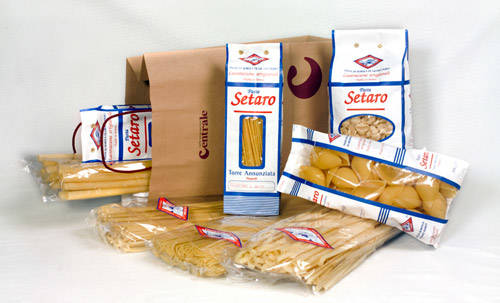Setaro, Ti Amo
We were driving from Napoli to eat pizza in Vico Equense when I saw the highway sign: Torre Annunziata.
For me, the sign signified one thing only: Setaro pasta. When I said as much to Dario and Enzo, our hosts during our stay in Napoli, they laughed. Dario, in the passenger’s seat, turned around and gave me a surprised look. But how do you know about Setaro? he wondered. Do you have it in America?
Certo! I replied. Rob, my partner, added that not only is Setaro available in New York, but that I hardly ever use any other brand.
It’s true. I love Setaro. I’m pazzo for it. Joe Sciorra wrote about his passion for figs in one of his I-Italy blogs. I’m as wild about the farinaceous creations of Torre Annunziata’s premier pastificio as Joe is about il fico.
I get my Setaro at Buonitalia, the great shop in Manhattan’s Chelsea Market owned and operated by Mimmo Magliulo and his wife Tonia. As far as I know, Buonitalia is the only outlet in New York where you can purchase it. Sometimes I think Mimmo ought to pay me a little stipend, or even better, reward me with bags of Setaro, for all the sales I’ve made for him.
In Buonitalia, packages of Setaro pasta are arrayed in open boxes along one wall of the store. On numerous occasions I’ve seen customers pick up a bag or two, examine it, and ponder whether to buy. This is where I step in. It’s the best pasta you’ll ever find, I say. “You use it?” they typically reply. Nothing else, I say. There usually follows a discussion of why I prefer Setaro to all other brands. They’re usually convinced by now. The remaining hurdle is the price – about $7 a bag. But, as I point out, those bags contain about two pounds (there are smaller, 17.1 ounce packages, too) and besides, you can’t argue with quality.
Sold!
So what makes Setaro so good?
Pastificio Fratelli Setaro, like so many Italian businesses, is a family concern, founded by Nunziato Setaro in 1939. Nunziato’s son Vincenzo runs the company today. Setaro produces pasta artigianale (artisanal pasta) using traditional techniques and production methods that most industrial pasta producers have abandoned. The Setaro product is made only from hard durum wheat flour (semolina) and water from near Mt. Vesuvius. The pasta is extruded through bronze dyes (trafile in bronzo) and then allowed to slowly air-dry at low temperatures. The use of bronze extruders, rather than the Teflon ones used by many industrial pastifici, produces a rougher surface that makes for an especially toothsome pasta that “holds” whatever sauce you use. It cooks up perfectly al dente, and is so flavorful that, even when dressed with the simplest sauces, like aglio olio, it’s great.
I wouldn’t think of making pasta chi sarde with any other bucatini. When I make a rich meat ragu, I use Setaro’s rigatoni or paccheri. For pasta alla matriciana, the spaghetti alla chitarra. For a simple sauce with ciliegini (cherry tomatoes), garlic and herbs, my favorite anti-clerical pasta, strozzapreti (priest-chokers). For a seafood sauce, the calamarata (shaped like calamari rings), linguini, or spaghetti.
The penne rigate al nero, made with black cuttlefish (seppia) ink, is a particular favorite when it comes to seafood pasta dishes. So, let me conclude with my recipe for pasta al pesce spada (swordfish) made with Setaro’s black, ridged penne. A caveat: this recipe is more of a guideline to preparing the dish than a formula. So feel free to vary ingredients and their amounts as you like.
One-half to 3/4 pound fresh swordfish, cut into small chunks
2-3 cups canned San Marzano tomatoes, chopped, or the equivalent in cherry tomatoes, halved
2-3 tablespoons chopped Italian parsley or basil, or both; or 1 teaspoon dried oregano and 2 tablespoons parsley
Whole garlic, 1-2 cloves, to taste
2 tablespoons chopped green Sicilian olives and 2 tablespoons chopped Pantelleria capers rinsed of their salt,
OR 2 tablespoons chopped Gaeta olives, no capers
4-6 tablespoons extra virgin olive oil
Salt and pepper to taste
1 lb Setaro penne rigate al nero (black penne)
Put a large pot of salted water on to boil. Meanwhile, in a large skillet, sauté garlic in olive oil until lightly browned, pressing it into the oil, and discard. (If you like your sauce piccante, you can add some hot red pepper to the oil.) Add chopped swordfish and sauté. When the fish is lightly cooked, add the tomatoes. Stir, mashing the fish into the tomatoes until they are blended. Add herbs, salt and pepper. Stir together and let simmer 10-15 minutes. (NOTE: If you’re using capers and olives, go easy on the salt.) Add capers and olives, stir, and let cook another five minutes.
Cook the pasta (about 11 minutes), and, when a little more than al dente, drain and add it to the pan with the sauce. Re-heat the sauce. If the pasta and sauce mixture is too dry, add some of the pasta water. Stir until sauce and pasta are blended, about 1-2 minutes. (This method is called in padella.) Serve, garnished with extra chopped parsley – and no cheese!
Buon appetito!
Visit Pastificio Fratelli Setaro online


































i-Italy
Facebook
Google+
This work may not be reproduced, in whole or in part, without prior written permission.
Questo lavoro non può essere riprodotto, in tutto o in parte, senza permesso scritto.